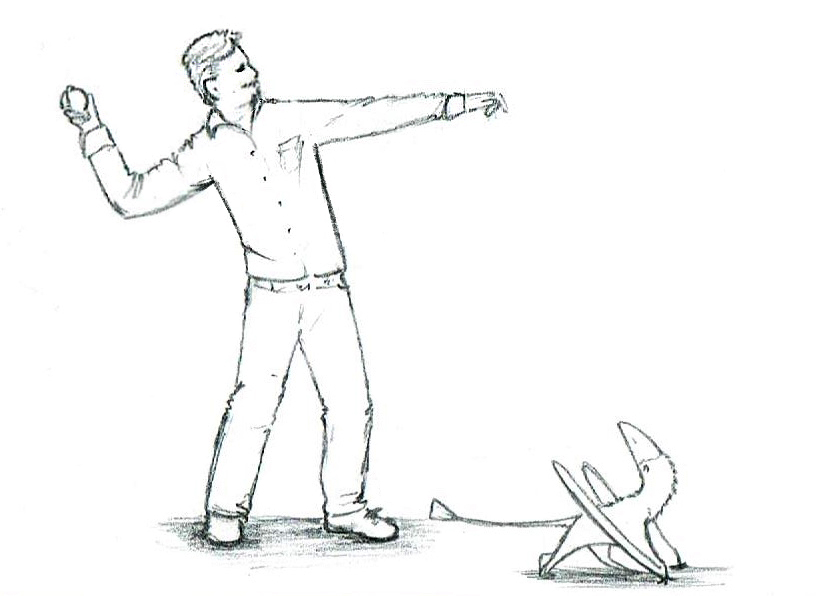Life is a lot like sailing an old-fashioned ship.
Continue reading

Continue reading
This sketchbook sneak peak is all about the upcoming Critter of the Month! As you might have guessed from last month’s clue, Yi Qi will be joining the critters at Pete’s Paleo Petshop.
Continue readingIt’s Dinovember, and I thought I’d have a little fun with one of those lists of dinosaurs floating around Instagram. Just a few critters, to shake things up a bit with a slightly different style and fun fact bits. The list I borrowed off of Instagram had mostly Cretaceous critters in it, but I decided I’d post a few here anyway. Enjoy!
Continue readingThe seasons are changing here in the Texas hill country.
The nights are cooler, the leaves on the pecans and sycamores are falling, yellow wildflowers like broomweed and ragweed are abuzz with busy bees and huge monarch butterflies, and everywhere you go the world is aglow with the golden hue sunlight seems to get at this time of year.
Continue reading

I was wondering…What do giant sauropods do when it rains? So I started a quick little comic about Elmer this month. I say started, because I only got halfway through. But we’ll see what happens to Elmer as we go through August. Enjoy!
Continue readingWhat do you like to do over the weekend?
Pete enjoys leisurely walks with the critters at the shop. Today he’s taking Opie the Ornitholestes and Nina the Nanosaurus.
Wait a second, don’t they have a rather antagonistic relationship? Well, yes, you’d be correct if we were talking about wild Ornitholestes and Nanosaurus, but domestic ones can learn to get along with the proper training. A well fed and regularly exercised Ornitholestes soon learns to ignore a Nanosaurus, especially one that is fully grown. Nina here will be just a little bigger than Opie once she reaches her full size, but that’ll be a while yet since she’s already mature and now in slow-growth mode.
Many dinosaurs grow very quickly in size when they’re young, like us. Once mature, we don’t grow any taller, but many dinosaurs will continue growing (at a much slower pace) for as long as they live.
Pete usually has a harness for Nina, but he doesn’t need one for Opie. Opie saw Pete for the first time when he hatched out of the egg, and he followed Pete around like a duckling follows its mother. He’s all grown up now, so he usually spends time out in his paddock, but he’ll still follow Pete around when he comes by. All the Ornitholestes that did not see Pete as a hatchling don’t do this, so he uses a harness anytime he needs to take them somewhere.

Out in the wild, a fully grown adult Nanosaurus wouldn’t have too much to worry about from an Ornitholestes, especially as a flock. Young chicks would definitely have to watch out though, like these hiding in the cycad fronds. Luckily for them, this Ornitholestes is only curious about the rustling in the foliage, and not particularly hungry. A hunting Ornitholestes would keep its head low, and move slowly and quietly. Then the young Nanosaurus would crouch low to the ground and sit absolutely still, ready to dart out of the stiff cycad leaves if they are found.

Thank you so much for stopping by! See you on August 1st for Critter of the Month! 😀
I have all sorts of pterosaurs flying and scampering around in my sketchbook lately.
Dimorphodon was a smallish flying reptile from the early Jurassic period. The first fossils were discovered by the famous paleontologist Mary Anning off the coast of England, and then named by Richard Owen himself in 1859. Despite its history, it’s not particularly well known aside from its appearance in the Jurassic Park franchise.
Now as much as people like to pick apart the inaccuracy of “those animals” from the Jurassic Park franchise, I will not be doing that here.

On the subject of monsters, I had a blast drawing some vintage antediluvian sea monsters and flying reptiles! I just love any excuse to draw old-fashioned dinosaurs and other prehistoric critters. I referenced some of the original etchings to draw these, so you may recognize them even if I added a few tweaks of my own.
Pterodactylus was the first prehistoric creature ever officially described. Some thought it was a bat-like mammal, which explains the fur here. I drew the wings based on the Pterodactylus sculptures at the Crystal Palace in London. I loved their swan-like grace, and I figured most scientists at the time thought the wings would be more like this instead of the odd circular shape in the original sketch. So even though this pterosaur closely references the first original sketch of Pterodactylus, I took the liberty of swapping out the wings with a model I imagine was far more common at the time.

Now that we’ve had fun with movie monsters and first guesses, let’s take a look at a more modern understanding of pterosaurs. Dimorphodon in particular.
Dimorphodon was rather unusual for a pterosaur. Its body is proportionally heavier than most other pterosaurs its size, and with its shorter wings may have preferred staying on the ground or clambering in the trees. Rather like turkeys do today. So how would you get Dimorphodon off the ground?
Something scary would certainly do it, but Pete prefers to show us this behavior by throwing a treat or a ball.


Thank you so much for stopping by! See you next week for another Sketchbook Sneak-Peak! 😀